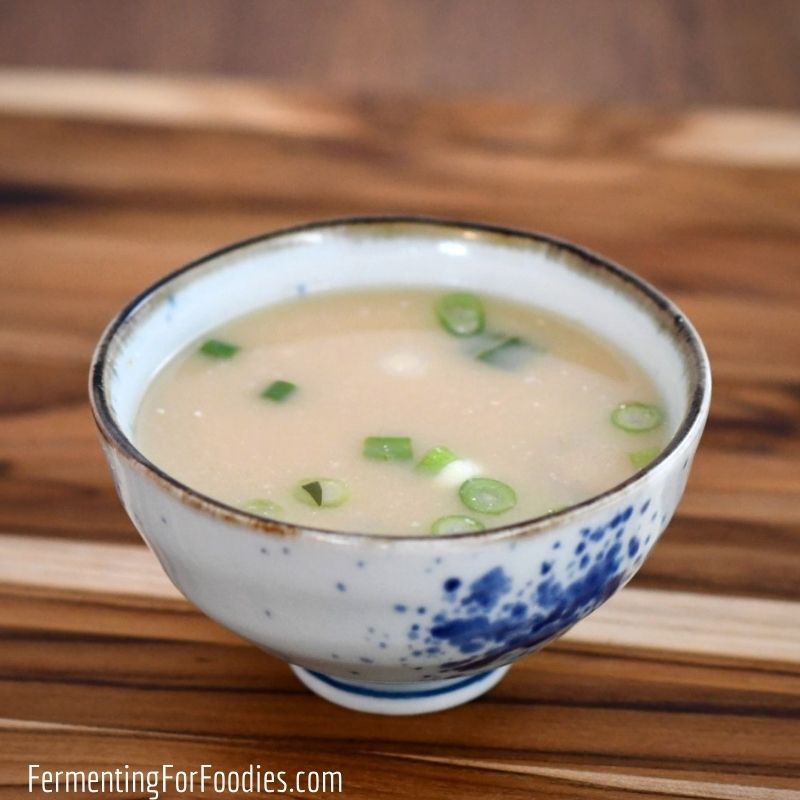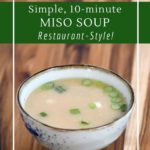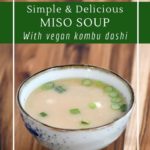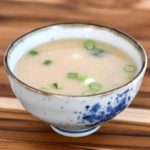We love throwing roll-your-own sushi parties. And what better way to start a sushi party than with a simple cup of miso soup?!

There are two options for this miso soup. If you have a lot of time, then I recommend making a dashi broth in advance. Otherwise, just use water for a nearly instant soup. Miso has plenty of flavor to offer this rich and delicious soup.
Why I Love Simple Miso Soup
I’ll admit a quick bowl of miso soup is one of my go-to recipes. It’s gluten-free, vegan, and full of nutrition. Since I make my own miso, it’s also probiotic! Even if you don’t make miso, you can find live, probiotic miso in the refrigerated section of your grocery store or online.
Here are a few ways to enjoy a quick cup of soup.
- A perfect opening dish for a Japanese meal.
- Serve it with sushi! I even make it when we buy takeout sushi. It’s that easy.
- Warming afterschool snack.
- Throw in a handful of rice vermicelli for a quick and healthy lunch.
- Looking for something more? Try my hearty miso soup.
Simple Kombu Dashi
Dashi is a Japanese soup broth that is used as the base for soups and noodle bowls. There are several different ways to make dashi. However, I like kombu dashi because it is simple and vegan. Kombu also happens to be a local product in my part of the world.
Kombu dashi is great as an all-purpose vegan soup broth. It’s loaded with flavor, vitamins, and minerals. How perfect is that!?
Making kombu dashi is simple… all you need is a bit of time.
- Measure 4 cups of water into a small pot. Add 1 or 2 large pieces of dashi kombu. Use about 4-inch (10cm) square.
- Bring to a boil and simmer for 20 minutes.
- Remove the kombu and your broth is ready!
Simple Miso Soup
Looking for traditional Japanese restaurant-style miso soup? This vegan miso soup is quick and easy to make.
- Prep Time: 5 minutes
- Cook Time: 10 minutes
- Total Time: 15 minutes
- Yield: Serves 4-6 1x
- Category: Soup
- Cuisine: Japanese
- Diet: Vegan
Ingredients
- 4 cups water or kombu dashi
- 1/2 cup of tofu cut into 1/4 ” cubes
- 1 tsp dried wakame or dulse flakes
- 3 Tbsp miso paste
- 2 spring onions (1/4 cup), chopped
Instructions
- See the section above for making kombu dashi. It’s not necessary, but it will add a lot of flavor and nutrients to this soup.
- Bring the water (or broth) to a boil. Add in the tofu and dried wakame and turn off the heat. Allow the soup to cool slightly while you mix the miso paste.
- To add the miso paste to the soup, remove 1 cup of broth from the pot. Mix the miso paste into the cup of broth until it’s fully dissolved.
- Stir the miso into the cooling soup. Garnish with spring onions and serve!
Notes
- Wakame
is seaweed flakes that are often used for seaweed salad.
- I realize that specialty Japanese ingredients aren’t sitting around in everyone’s pantry. If seaweed isn’t your thing, then skip the kombu broth and wakame, and just use 4 cups of vegetable broth instead.
Nutrition
- Serving Size: 1 cup
- Calories: 33
- Sugar: 0.3g
- Sodium: 350mg
- Fat: 1.4g
- Saturated Fat: 0.2g
- Carbohydrates: 2.8g
- Fiber: 0.3g
- Protein: 2.9g
- Cholesterol: 0mg




Looks great! Do you save and reuse the kombu?
I haven’t done that. We do eat a lot of seaweed. I’m not sure how to use kombu beyond as a broth, since it’s so tough. Do you have a favorite kombu recipe?
I put kombu in soups in small pieces or into my dried beans when cooking them
What a good idea. Thanks for sharing!
Very good miso soup recipe.
I never realized that miso soup used a seaweed broth. My kids both LOVE miso soup but there aren’t many restaurants nearby that serve it. I’ve tried making it at home but it was never quite right. I ordered some kombu online and followed your recipe this afternoon and it’s PERFECT! My kids were thrilled and guzzled the whole pot as an after school snack. Okay, I helped, but I couldn’t resist. It’s so good! Thank you for sharing this fantastic recipe!
Great! I’m so glad that you and your kids enjoy it! Seaweed broth is definitely the flavor secret. 🙂
the miso soup a restaurant near us serves is very clear, like a chicken broth. how would I make that?
Miso will always cause miso soup to be cloudy. It’s part of the product (rice & soybeans). I’m guessing your local restaurant is using very little miso. If it’s pale in color, it could be because they are using white miso. Cheers!